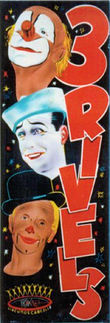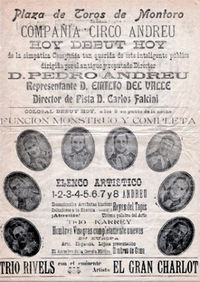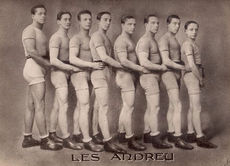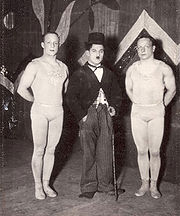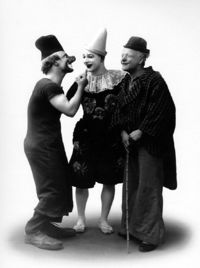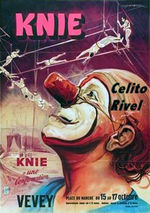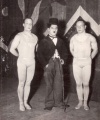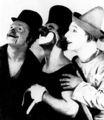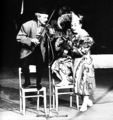Difference between revisions of "The Andreu-Rivels"
From Circopedia
(→René, Rogelio & Celito) |
(→René, Rogelio & Celito) |
||
| Line 47: | Line 47: | ||
After World War II, René, Celito, and Rogelio still performed the now classic Andreu-Rivels acts with the same success in major European circuses, including [[The Hagenbeck Dynasty|Hagenbeck]], [[Circus Williams|Williams]], [[Circus Scott|Scott]], [[The Strassburger Family|Strassburger]], [[Cirque Pinder|Pinder]], [[Cirque Amar|Amar]], and several engagements with Circus Knie in Switzerland. It was there, in 1952, that Celito performed his Tramp parody on the trapeze in front of an appreciative Charlie Chaplin—the act that had given his brother José his stage name: Charlie. The Andreu-Rivels also appeared in several television shows in Europe, and twice on the ''Ed Sullivan Show'' (1962 and 1965) in the United States. | After World War II, René, Celito, and Rogelio still performed the now classic Andreu-Rivels acts with the same success in major European circuses, including [[The Hagenbeck Dynasty|Hagenbeck]], [[Circus Williams|Williams]], [[Circus Scott|Scott]], [[The Strassburger Family|Strassburger]], [[Cirque Pinder|Pinder]], [[Cirque Amar|Amar]], and several engagements with Circus Knie in Switzerland. It was there, in 1952, that Celito performed his Tramp parody on the trapeze in front of an appreciative Charlie Chaplin—the act that had given his brother José his stage name: Charlie. The Andreu-Rivels also appeared in several television shows in Europe, and twice on the ''Ed Sullivan Show'' (1962 and 1965) in the United States. | ||
| − | [[File:Circus_Renée_Rivel_(1978).jpg|thumb|right| | + | [[File:Circus_Renée_Rivel_(1978).jpg|thumb|right|180px|Rogelio & Johnny Rivels and Fofo Marquez (1978)]]René, Celito and Rogelio performed their trapeze act for the last time in 1963: Celito was 57 at the time, René was 60. Celito died six years later, in 1969; he was replaced by the Portuguese clown Fernando ("Fofo") Marquez—the first time that a member of the Andreu-Rivels trio was not himself an Andreu. Then in 1971, Johnny Rivels, René's son, replaced his father. At that point, it can be said that the Andreu-Rivels trio of legend had ceased to exist: René had been the immutable central figure of the act, in whatever formation, since its inception in 1920, and the celebrated trio had evolved around him. René passed away in 1976, at age 73. |
In 1978, Rogelio Rivel entered in an agreement with a former concession manager for [[Circus Willy Hagenbeck]] to launch a ''Circus Rivels''. This was not to the taste of Charlie Rivel, who didn't want his own name, still very well known in Germany, to be confused with that of his brothers: The circus title was changed to ''Renée Rivels''. Charlie also lobbied his friends among German circus owners to make sure that the new circus had a difficult start... The stars of the show were the 3 Rivels: Rogelio and Johnny, with Fofo Marquez, who were supported by a solid program. As expected, the tour had a shaky start, but it went on—until tragedy struck: Fofo Marquez was electrocuted and died in a freak accident. Rogelio Andreu-Rivel decided to close the show, which had lasted only a few months. | In 1978, Rogelio Rivel entered in an agreement with a former concession manager for [[Circus Willy Hagenbeck]] to launch a ''Circus Rivels''. This was not to the taste of Charlie Rivel, who didn't want his own name, still very well known in Germany, to be confused with that of his brothers: The circus title was changed to ''Renée Rivels''. Charlie also lobbied his friends among German circus owners to make sure that the new circus had a difficult start... The stars of the show were the 3 Rivels: Rogelio and Johnny, with Fofo Marquez, who were supported by a solid program. As expected, the tour had a shaky start, but it went on—until tragedy struck: Fofo Marquez was electrocuted and died in a freak accident. Rogelio Andreu-Rivel decided to close the show, which had lasted only a few months. | ||
Revision as of 01:02, 22 September 2013
Clowns
By Raffaele De Ritis and Dominique Jando
The career of the Andreu-Rivels (also known as The 3 Rivels) spanned half a century, from 1920 to 1970. With a trio that has seen three different compositions while remaining centered around René Rivel, the brothers Andreu (Charlie, Polo, René, Celito, and Rogelio) were one of Europe’s most successful and celebrated clown act—even though over the years, their fame has been unduly shadowed by the stature (and it can be said, the considerable ego) of one of the trio's original members, Charlie Rivel, who left his brothers in 1935 to replicate the family act with other, anonymous partners and eventually pursue a "solo" career (albeit never without uncredited partners).
The Andreu Family
Their father, Pedro Jaime Andreu Pausas (?-1957), was the son of a cabinetmaker from Barcelona, Spain. In the 1880s, when he was fifteen years old, Pedro and his brother Juan left home to follow Circo Milá. As members of the circus, Pedro and Juan began performing a trapeze act. Pedro later joined another circus, Circo Alegría, where he met—and later married—a French acrobat, Marie-Louise Lasserre Seguino. Spain had fallen on hard times, and in order to survive, the young family decided to cross into France, where they hoped to find work. As they made their way toward the border, they performed in village squares across Catalonia.In 1896, they were traveling in a hand-drawn wagon when Marie-Louise gave birth to José (the future Charlie, 1896-1983) in Cubelles, a village near Barcelona. Surviving as best they could, they finally reached France three months later. They soon secured an engagement with the small Cirque Dusoulier. The following year, Marie-Louise gave birth to her second child, a daughter, Neña (Marie-Louise Andreu, 1897-1915). At age two, little José appeared in his father's risley act. Then the family went on to perform with the Cirque Caignac, where little José appeared in a parody of a strong-man act and in a hand-to-handAn acrobatic act in which one or more acrobats do hand-balancing in the hands of an under-stander. balancing act with his sister, for which he was originally dressed as a girl—which made their "all-girl" act look more attractive to agents and directors.
While they were touring in France, the family continued to grow: Polo (Paul, 1899-1977) was born in Avallon in 1899, and René (1903-1976) in Aubusson in 1903. Then, the Cirque Caignac was destroyed by a storm in 1904, and the Andreu family again fell to performing in village squares—the children doing a variety of acts, including acrobatic dancing, perch-poleLong perch held vertically on a performer's shoulder or forehead, on the top of which an acrobat executes various balancing figures. balancing, and a hand-balancing—before joining the Cirque Caron in Grenoble. There, the Andreu siblings learned trickAny specific exercise in a circus act. riding and began to play musical instruments.
The Andreu family went on to perform in other small French circuses, where José, Neña and Polo appeared in a balancing trio called Los Pepitos. It was probably in 1905, at the circuses Zanfretta and Lambert, that the three siblings began work on their standing-frame flying-trapeze act, with Neña as the catcherIn an acrobatic or a flying act, the person whose role is to catch acrobats that have been propelled in the air.. The following year, in 1906, José got a first taste of clowning, when the director, Monsieur Lambert, called on him to replace the house clownGeneric term for all clowns and augustes. '''Specific:''' In Europe, the elegant, whiteface character who plays the role of the straight man to the Auguste in a clown team., Carleto. Celito (Marcel, 1906-1969) was born that year in Elbeuf, and Rogelio (Roger, 1909-2001) three years later, in 1909, in Roubaix. They would soon become part of the family acts.After finally being accepted by a talent agency, the Andreus began to work regularly in French circuses. In 1910-12, they appeared in several minor variety theaters in Paris and on the stage of various Italian theaters. In 1913, during an engagement with the French Cirque Alphonse Rancy, Pedro Andreu performed for the first time with his family in his native Catalonia, at Barcelona's Tivoli, before opening his own Circo Reina Victoria in 1915. José (under the name Boby) and Polo performed their first clown entrée(French) Clown piece with a dramatic structure, generally in the form of a short story or scene. in the new family circus.
The Andreus' new circus venture lasted about ten years, alternating with foreign contracts. The family's main act remained their standing-frame flying-trapeze act, in which José started developing a comic character. Their second act was a large risley presentation (a widely popular specialty at the time), which included their father and another catcherIn an acrobatic or a flying act, the person whose role is to catch acrobats that have been propelled in the air.. In time, Celito and Rogelio would also develop an acrobatic and juggling act.
Charlie and The Rivels
In the late 1910s, circus and variety shows were invaded by parodies of Charlie Chaplin, whose extremely popular movie character, the Tramp, had become a customary comic addition to specialty acts in need of a comedy boost. José, who already used comedy in the trapeze act he now did with his brothers René and Polo, introduced his "Charlie" character in 1916 in Madrid. To distinguish their trapeze act from the Andreus' risley act on the bills, the family titled it Charlie and the Rivels (Charlot et les Rivels). From then on, José Andreu would be known as Charlie Rivel.The legend later perpetrated by Charlie Rivel is that the brothers simply made up the name Rivel by picking letters at random. As a matter of fact, Rivel had been for a long time the stage name of Pedro Andreu, which he used for all the acrobatic troupes he created with his partners and children. Where the name actually came from remains a matter of speculation.
Meanwhile, René and Polo, with René as the traditional whiteface clown and Polo as his augusteIn a classic European clown team, the comic, red-nosed character, as opposed to the elegant, whiteface Clown., had developed a clown duet. During a tour in Morocco, Charlie became "Boby" again, and joined the act. Since Charlie had a gift for comedy, they decided to form a clown trio, in the fashion of the successful Fratellini brothers, the shining stars of Paris's Cirque Medrano. Their father helped them develop an entrée(French) Clown piece with a dramatic structure, generally in the form of a short story or scene. that made good use of their exceptional acrobatic skills. It became the brothers' second act.
The success of the Rivels' comedy-trapeze act, coupled with the Andreu clown trio, propelled them into big-time circuses and variety theaters: the London Coliseum in 1923 and, the following year, Cirque d'Hiver in Paris, where they were a sensation with the savvy Parisian circus audiences. Bertram Mills Circus at London's Olympia quickly followed.
The Rivels were allegedly sued by United Artists for using the Chaplin movie persona without permission (perhaps simply for doing it too well and too successfully, for there were hundreds of Chaplin impersonators in the business). Charlie consequently performed in the trapeze act as a generic drunk character. In any event, the Rivels continued to work in the most prestigious houses, including Cirque Medrano in Paris (1925), the Scala in Berlin (1927), and Cirkus Schumann (1928).Soon their Andreu clown trio began to gain preeminence over their Rivels trapeze act. Although they were clearly inspired by the Fratellinis' trio structure, the Andreus had the advantage of their exceptional acrobatic talents, and they were soon recognized as one of the best clown trios of their time. René was the whiteface clownGeneric term for all clowns and augustes. '''Specific:''' In Europe, the elegant, whiteface character who plays the role of the straight man to the Auguste in a clown team.; Polo was the first augusteIn a classic European clown team, the comic, red-nosed character, as opposed to the elegant, whiteface Clown., or contre-pitre; and Charlie was the second augusteIn a classic European clown team, the comic, red-nosed character, as opposed to the elegant, whiteface Clown.. They had two main entrées in their repertoire: an egg routine, and their famous acrobatic sketch, The Little Bridge, in which they tried to build (eventually succeeding) what is known in circus acrobatics as a bridge—a sort of moving human bridge.
Their clown act could easily last up to thirty-five minutes: Clowns, in the European circus, are often the stars of the show. Charlie, like Albert Fratellini, quickly became the central figure of the trio, and like Albert Fratellini, he developed an eccentric character with exaggerated makeup and costume. Charlie's signature red hair, large square red nose, long red T-shirt, oversized black shoes, and childish behavior became familiar all over Northern Europe. Yet, Polo, with his high-pitched, plaintive voice, was also highly recognizable.
In 1930, the trio embarked on a one-year South American tour before returning to the vast German circus and variety circuit. But the working atmosphere between the siblings had deteriorated. Charlie, the most identifiable of the brothers, was the star, and he knew it. He resented the fact that his father still ran the trio's business, and wanted a larger share of the act's substantial income. In 1935, at the Circus-Varieté Schumann of Frankfurt, Charlie decided to part ways with his father and brothers and to build a career of his own with his sons and his wife.
René, Rogelio & Celito
Charlie's departure was marred by a series of lawsuits regarding such professional technicalities as the rights to use the stage name Rivel, or the ownership of Charlie's famous expression, "Akrobat — schööön!" ("Acrobat — beauuutiful!"). These issues were eventually settled; it was ruled that the name Rivel belonged to all the siblings, having to be used with their first name in front, and Charlie could keep his trademark expression. Celito, who took Charlie's place, eventually used a variant: "Acrobat — oh, süüüß!" ("Acrobat — oh, sweeet!').René, Polo and Celito continued to perform the same acts in German variety theaters, with no less success than they had enjoyed before. Celito had replaced Charlie in the flying-trapeze act as well as the clown entrée(French) Clown piece with a dramatic structure, generally in the form of a short story or scene., and the younger Rogelio also joined the act in 1937. Then, in 1941, it was Polo's turn to leave the family acts. He worked for a time with the well-known French clown Alex Bugny, then with Andreff and Louis Comotti at Circus Knie in 1943, before teaming up again with Alex Bugny and finally embarking on a "solo" career, with the help of his sons. Rogelio took his place in the trio.
After World War II, René, Celito, and Rogelio still performed the now classic Andreu-Rivels acts with the same success in major European circuses, including Hagenbeck, Williams, Scott, Strassburger, Pinder, Amar, and several engagements with Circus Knie in Switzerland. It was there, in 1952, that Celito performed his Tramp parody on the trapeze in front of an appreciative Charlie Chaplin—the act that had given his brother José his stage name: Charlie. The Andreu-Rivels also appeared in several television shows in Europe, and twice on the Ed Sullivan Show (1962 and 1965) in the United States.
René, Celito and Rogelio performed their trapeze act for the last time in 1963: Celito was 57 at the time, René was 60. Celito died six years later, in 1969; he was replaced by the Portuguese clown Fernando ("Fofo") Marquez—the first time that a member of the Andreu-Rivels trio was not himself an Andreu. Then in 1971, Johnny Rivels, René's son, replaced his father. At that point, it can be said that the Andreu-Rivels trio of legend had ceased to exist: René had been the immutable central figure of the act, in whatever formation, since its inception in 1920, and the celebrated trio had evolved around him. René passed away in 1976, at age 73.In 1978, Rogelio Rivel entered in an agreement with a former concession manager for Circus Willy Hagenbeck to launch a Circus Rivels. This was not to the taste of Charlie Rivel, who didn't want his own name, still very well known in Germany, to be confused with that of his brothers: The circus title was changed to Renée Rivels. Charlie also lobbied his friends among German circus owners to make sure that the new circus had a difficult start... The stars of the show were the 3 Rivels: Rogelio and Johnny, with Fofo Marquez, who were supported by a solid program. As expected, the tour had a shaky start, but it went on—until tragedy struck: Fofo Marquez was electrocuted and died in a freak accident. Rogelio Andreu-Rivel decided to close the show, which had lasted only a few months.
Rogelio, the last of the legendary Andreu-Rivel trio, returned to Spain, while Johnny Rivel remained in Germany, where he established himself as a music composer. Rogelio continued to be active until his death in 2001, and had ensured the continuation of the Andreu-Rivels' legacy with the opening in 1999 of the Escola de Circ Rogelio Rivel, the first circus school in Barcelona.
See Also
- Biography: Charlie Rivel
